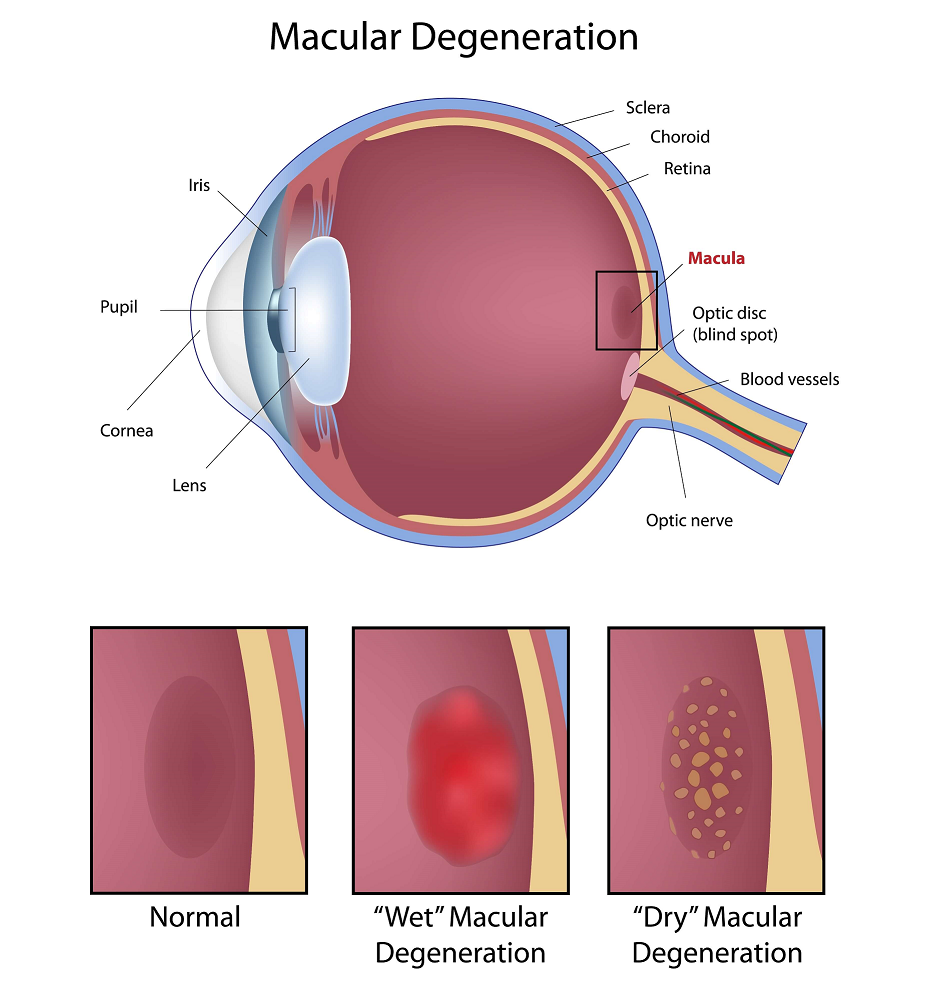
February is Age-Related Macular Degeneration and Low Vision Awareness Month. Age-Related Macular Degeneration (AMD) is the leading cause of blindness among older Americans, but new treatments have dramatically changed the course of this disease over the last 10 years, making AMD more manageable than ever before.
During AMD Awareness Month in February, the American Academy of Ophthalmology is reminding people with AMD that they can save their vision thanks to recent treatment advances, but early detection is a critical first step.
What is Age-Related Macular Degeneration (ARMD)?
Macular degeneration is a condition that affects the macula. The macula is a small piece of tissue located in the central portion of your retina. The macula is responsible for your sharp, central vision. Macular degeneration, an age related condition, occurs when either yellowish deposits grow under the macula or blood vessels grow and leak into the eye cavity. There are two types of AMD, dry and wet. Both types of AMD can cause blind spots, but not complete blindness. Vision loss due to macular degeneration cannot be reversed.
Dry Age-Related Macular Degeneration (DRY AMD)
About 85% to 90% of people with age-related macular degeneration have dry AMD. Dry AMD is liked with bits of fat and protein called drusen. They can collect under your retina — a layer of tissue at the back of your eye that processes light. No one knows where the drusen come from, but they are thought to be pieces of waste from the retina.
If you’re over the age of 50 you probably have some hard drusen in your eyes. These are normal and harmless, especially if they aren’t in your macula — the small area at the center of your retina. But soft, large, and centrally located macular drusen are not. They are the ones that are linked with losing your vision.
Drusen in early AMD are quite small. They get larger as the condition moves from early to intermediate to advanced. In advanced-stage AMD, drusen are larger and more numerous. They keep oxygen from reaching your eye.
The vision loss from dry AMD happens slowly and usually is not as severe as that from wet AMD. But dry AMD can sometimes turn into the wet form. Up to 5% of people who have dry AMD in both eyes will get wet AMD in a year, while 13% to 18% will get it in 3 years.
Wet Age-Related Macular Degeneration (Wet AMD)
Wet AMD usually gets worse much more quickly than dry AMD. If you have this type, extra blood vessels start to form in your eye underneath the macula. These new vessels tend to leak blood and other fluid into your eye, which causes damage. It’s not clear exactly why the vessels form, although some experts think it may be part of an effort to get rid of the drusen.
Macular degeneration can be very serious.
- Macular degeneration is a leading cause of vision loss in Americans 60 years of age and older.
- Advanced age-related macular degeneration is a leading cause of irreversible blindness and visual impairment in the world.
- Age-related macular degeneration is an irreversible destruction of the macula, which leads to loss of the sharp, fine-detail, “straight ahead” vision required for activities like reading, driving, recognizing faces, and seeing the world in color.
Macular degeneration is widespread.
- As many as 11 million people in the United States have some form of age-related macular degeneration. This number is expected to double to nearly 22 million by 2050.
- The number of people living with macular degeneration is expected to reach 196 million worldwide by 2020 and increase to 288 million by 2040.
- Age is a prominent risk factor for age-related macular degeneration. The risk of getting advanced age-related macular degeneration increases from 2% for those ages 50-59, to nearly 30% for those over the age of 75.
Top Causes For Age-Related Macular Degeneration (ARMD)
- Genes
- Age
- Race and ethnicity
- Gender
- Smoking
- High blood pressure
- Heart disease
- Obesity
- Too much sun
- Medications
- Diet and alcohol
- AMD in one eye
There are treatments available that can slow or stop the progression of this disease. For more information about Age-Related Macular Degeneration (AMD), come see our retina experts here at Family Eye Physicians to see which treatments are best for you.
Family Eye Physician Locations: Buffalo Grove, Chicago, Orland Park, and Oak Lawn. Contact us online or Call Us at (708) 636-9393 today!
 708.636.9393
708.636.9393

